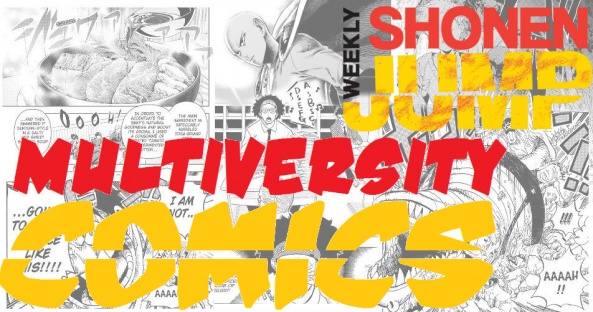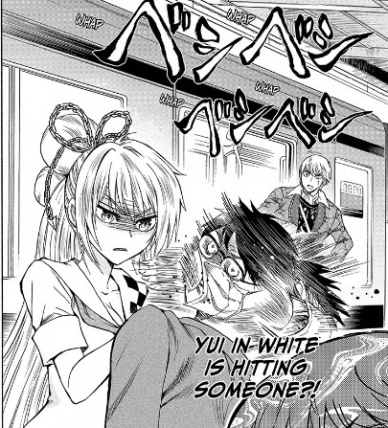
Welcome to This Week in Shonen Jump, our weekly check in on Viz’s various Shonen Jump series. Viz has recently changed their release format, but our format will mostly remain the same. We will still review the newest chapters of two titles a week, now with even more options at our disposal. The big change for our readers is that, even without a Shonen Jump subscription, you can read these most recent chapters for free at Viz.com or using their app.
This week, Rowan and Walter check in with “Samurai 8” and “Yui Kamio Lets Loose.” If you have thoughts on these or any other current Shonen Jump titles, please let us know in the comments!

Samurai 8 Chapter 1
Written by Masashi Kishimoto
Illustrated by Akira Okubo
Reviewed by Rowan Grover
The first chapter of Masashi Kishimoto, famed creator of “Naruto”, and collaborator Akira Okubo’s new manga saga comes with heavy expectations, but the two creators handle action manga as effortlessly as breathing. To clear out the way, there are tropes here that fans of “Naruto” will notice pop up in Kishimoto’s script. You’ll notice elements like special fighting moves having their own specific names (more of a general Shonen element, but still) and having the protagonist be born with the burden of having a special magic MacGuffin placed inside him by his parent (i.e. Naruto’s Nine-Tailed Fox).
Once we get past that, however, our protagonist Hachimaru is a genuinely likable guy. He works as a solid wish-fulfillment character since he suffers from a disability, being unable to walk or even exist outside of being hooked up to a life support machine. Naturally, Kishimoto pens him with some rebellious attitude, as he curses his father for always shutting him in and perpetually delaying his return to health. Hachimaru does balance this, however, by regretting his actions in the quiet moments when his dad is not around. Their relationship is one of the most genuine parts of this story, culminating in an especially moving panel where Hachimaru exclaims his love for his Dad (yes, I cried).
The story and the world lore is also fairly original for a Shonen manga and a Kishimoto-penned manga, at that. The world takes a lot obviously from Japanese Samurai culture, but also seems to infuse it with elements of Buddhist rebirth (Daruma being reborn into a Cat’s body and Samurais being reborn into cyborg bodies as a gift from a deity). Not only that but the sci-fi elements have a very European bandes dessinées tone. The use of samurai cyborg bodies that unlock to reveal a “key” and pet companions that morph into armor feels like a concept that would have fit perfectly into an Alejandro Jodorowsky comic, and it gives “Samurai 8” a whole new level of originality.
I was skeptical at first for someone other than Kishimoto to be drawing this book, but Akira Okubo goes above and beyond her, surpassing all expectations. The general design of the series, like the tone of the script, has a very east-meets-west tone to it. The opening sequence has some lovely colors to boot, infusing soft blues and citrus orange to create a serene, yet high-concept science fiction feeling. Looking deeper, the area where Hachimaru lives reflects this too. The house looks like something from a Euro-fairy tale, with lots of round edges and a mushroom-esque rooftop, yet the furnishings feel traditionally Japanese – lots of hardwood, open floors and little to no furniture. There are some great setting panels scattered throughout too. Okubo slays a panel depicting Hachimaru’s dad riding into town, where the landscape curves underneath him with a fishbowl effect, showing more of these mushroom-esque houses and energetic, exciting landscape.
Okubo’s action sequences are incredibly original and forward thinking, to the point that as much fun as they are in their chaos, they can be a little hard to follow at times. The opening, virtual-reality sequence breaks down how the fighting works pretty quickly and elegantly. Each opponent in this scene gets a side of the six-panel grid page, where they both develop their abilities and armor at the same time but with different techniques. The use of cyborg bodies allows for some super creative fights, where limbs seem to float Rayman-esque away from their bodies and bits and pieces of armor hover around like a physical aura. This visually-complex action can get a little complex at times, like in Hachimaru’s first fight towards the end of the issue, when we’re supposed to see a battle-deciding move that for me took a few reads to partially understand. However, it soon empties out to make a spectacular double-page spread that looks like a futuristic, Samurai-tinged jousting match, which pulled me right back into the story.
Continued below“Samurai 8” may vaguely cover the usual Shonen tropes, and even share some similarities with Kishimoto’s other work, but the way that it pulls these ideas off is refreshing and exciting. Hachimaru is an instantly loveable protagonist, with flaws and all, and the world feels like a great genre blend that I can’t wait to sink my teeth into. Akira Okubo supplies seamless, flowing and richly layered art than although can get a little overwhelming at times, is endlessly gorgeous to take in. This is undoubtedly one to keep an eye on, folks.
Final Score: 8.2 – Kishimoto and Okubo’s “Samurai 8” doesn’t reinvent the Shonen wheel, but certainly decks it out with cool cyborg armor and brilliantly charming characters.

Yui Kamio Lets Loose Ch. 9
Written and Illustrated by Hiroshi Shiibashi
Reviewed by Walt Richardson
The latest chapter of “Yui Kamio Lets Loose” delves more into what makes it unique from your average shonen romantic comedy. The vast majority of these kinds of stories always come down to a choice between two love interests, usually a girl who is coded “good” and one who is coded “bad.” There may be other ladies that show interest in the protagonist (who is often a cypher with few characteristics other than “he’s nice” or “he’s funny” that the reader can project themselves onto), but from the first few chapters its usually obvious that, in the end, the protagonist will have to make a choice between the two of them. “Yui Kamio” takes that to an extreme: the Good Girl and the Bad Girl literally cannot coexist.
The first few chapters have mainly dealt with Kiito’s growing affections for Yui in White, with Yui in Black appearing mostly as a complication that needs to be dealt with. Yui in White, however, does not appear at all in this chapter (don’t let that second page fool you!), meaning that this is one of our first chances to get to know Yui in Black as a character beyond just being a hellion. To be honest, there still doesn’t appear to be that much to her than that, but scenes like her stopping a salary man from committing suicide, however brusquely, do a lot to make the inevitable approaching conflict between whether Kiito should choose Yui in White or Yui in Black much less one-sided. Furthermore, the White/Black dynamic is fleshed out more, with the reveal that Yui in Black hasn’t attended school since fifth grade adding in something that at least resembles a moral complication. To be sure, it is still at its core a silly and occasionally raunchy comedy, but the core hook of the story is interesting enough to make the series stand out from the chaff, and Hiroshi Shiibashi seems to already be thinking of ways to push and pull at the central conceit in order to keep it fresh.
Unfortunately, Shiibashi’s art still isn’t much to write home about. Stylistically, his character design is fairly generic, doing little to differentiate itself from similar series (though this chapter does have an exception with the horrific thug that runs into Yui in Black and co.). The backgrounds are usually sparse, though the use of varied screentones usually keeps things interesting. But the fundamentals are there: the storytelling is usually crisp and easy to follow, even in the more hectic scenes where the titular Yui Kamio titularly lets loose, and Shiibashi’s facial expressions deliver the intended comedic effect when needed. While Shiibashi’s art may raise the story up, it certainly doesn’t bring it down, either.
Final Verdict: 7.0 – Good clean (well, maybe not too clean) fun.






